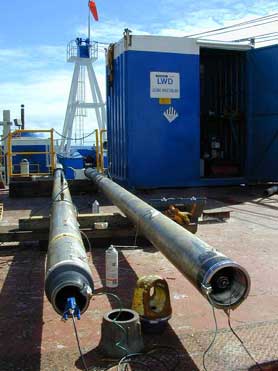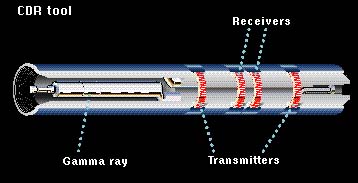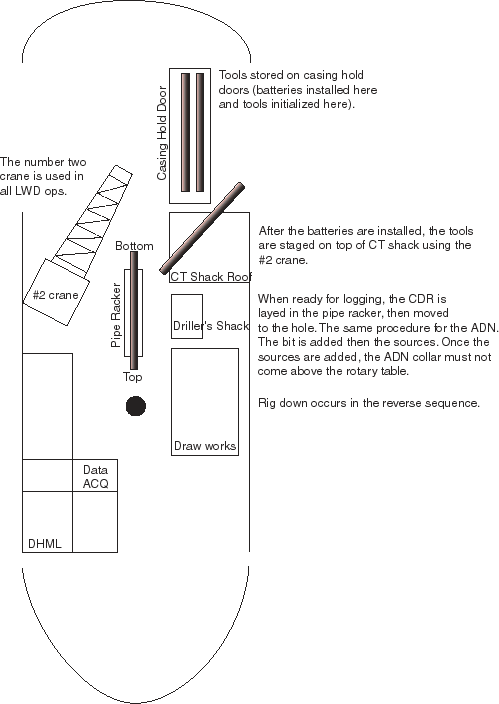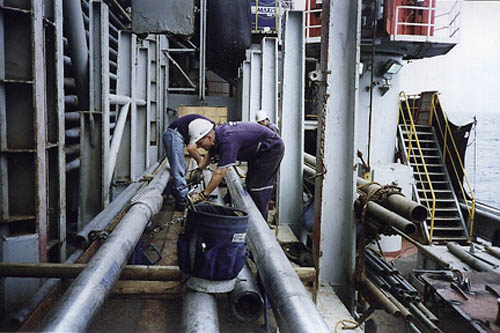Logging-While-Drilling—Compensated Dual Resistivity Tool (LWD-CDR*)
Description

The LWD-CDR was an electromagnetic propagation and spectral gamma ray tool built into a drill collar. It had many similarities to dual induction tools: it responded to conductivity rather than to resistivity, operated in water- or oil-base muds, and provided two depths of investigation. It had better vertical resolution, but a shallower depth of investigation, than dual induction tools.
The tool broadcasted a 2-Mhz electromagnetic wave and measured the phase shift and the attenuation of the wave between two receivers. These quantities were transformed into two independent resistivities that provided the two depths of investigation. The phase shift was transformed into a shallow resistivity (PSR); the attenuation was transformed into a deep resistivity (ATR).
The LWD-CDR had upper and lower transmitters that fired alternately. The average of these phase shifts and attenuations for the upward and downward propagating waves provided a measurement with borehole compensation similar in principle to that of the Borehole-Compensated Sonic Tool (BHC). Borehole compensation reduces borehole effects in rugose holes, improves the vertical response, increases measurement accuracy and provides quality control for the log. An electrical hole diameter was computed from the CDR data and was used as an input to hole size corrections.
Detection of 3 in. (7.5 cm) beds was possible with the CDR tool. However, because of shoulder bed effects, Rps and Rad will read too low in a thin, resistive bed with conductive shoulder beds, and a small correction for bed thickness was required to obtain true resistivity, Rt. A major advantage of the CDR tool was its ability to measure Rt in thin beds before invasion occurs. Once thin beds are deeply invaded, there is no reliable method for obtaining true resistivity.
The LWD-CDR was deployed during the Ocean Drilling Program from 1994—2000. It has been superceded by the LWD-arcVISION.
Applications – Resistivity Measurement
Porosity. In sediments that do not contain clay or other conductive minerals, the relationship between resistivity and porosity has been quantified by Archie’s Law. Archie’s Law relates the resistivity to the inverse power of porosity. This relationship has also been used to estimate apparent porosity in oceanic basalts.
Density and velocity reconstruction. Archie’s equation has been used effectively to create “pseudodensity” and/or “pseudovelocity” logs from porosity over intervals where no such logs were recorded or were totally unreliable. In some instances velocities derived from resistivity logs can be used to depth-tie seismic reflectors.
Lithologic boundary definition and textural changes. Resistivity, along with acoustic and velocity logs, is a very valuable tool in defining lithologic boundaries over intervals of poor core recovery. In a particular example, the decrease in resistivity towards the top of a carbonate unit, coupled with a decrease in velocity, allowed one to interpret this unit as a fining-upward sequence in mostly carbonatic sediments. Similar saw-toothpatterns in the resistivity response can also be observed in oceanic basalt units where they are related to porosity changes towards the top of each unit.
Applications – Natural Gamma Ray Measurement
Clay typing. Potassium and thorium are the primary radioactive elements present in clays; because the result is sometimes ambiguous, itcan help combining these curves or the ratios of the radioactive elements with the photoelectric effect from the lithodensity tool.
Mineralogy. Carbonates usually display a low gamma ray signature;an increase of potassium can be related to an algal origin or to the presence of glauconite, while the presence of uranium is often associated with organic matter.
Ash layer detection. Thorium is frequently found in ash layers. The ratio of Th/U can also help detect these ash layers.
Environmental Effects
The CDR tool provided a set of corrections for different environmental effects. These included corrections for adjacent formations, borehole signal, and invasion. Differences in the temperature of drilling fluid compared to undisturbed formation temperatures can also generate environmental effects, as conductivity in ionic fluids such as seawater is strongly temperature dependent.
Log Presentation
Attenuation Resistivity (ATR) and Phase Shift Resistivity(PSR) were usually plotted in ohm-m on a logarithmic scale along with gamma ray (GR) log in API units.
A full display of the Natural Gamma Spectroscopy data with SGR(total gamma ray in cps), CGR (computed gamma ray — SGR minus Uranium component — in cps), and THOR (in ppm), URAN (in ppm),and POTA (in wet wt%) was usually provided separately.
Tool Specifications
| Temperature rating: | -13° to 300° F (-25° to 150° C) |
| Pressure rating: | 18 kpsi (124 MPa) |
| Length: | 22 ft (6.7 m), with savers |
| Weight: | 2000 lbf (907 kg) |
| Maximum flow rate; | 600 gal/min |
| Maximum weight on bit: | F = 63,000,000/L² lbm (where L is the distance between stabilizers in feet) |
| Available collar sizes: | 6.75 in, 8.25 in (17.1 cm, 21 cm) |
| Available stabilizers: | 8.50 in, 9.75 in (21.6 cm, 24.8 cm) |
Major Outputs
| GR | Gamma ray (API Units) |
| SGR | Total gamma rRay (API units) |
| CGR | Computed gamma ray (API units) |
| POTA | Potassium (wet wt. %) |
| THOR | Thorium (ppm) |
| URAN | Uranium (ppm) |
| ATR | Attenuation resistivity (deep; ohm-m) |
| PSR | Phase Shift resistivity (shallow; ohm-m) |
| GTIM | CDR gamma ray time after Bit (sec) |
| RTIM | CDR resistivity time after Bit (hr) |
Deployment Notes
* ®trademark of Schlumberger



